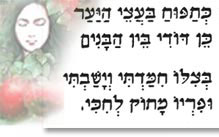|


|
The
apple has long been regarded as a symbol of desire. The Romans linked
the apple to Venus, the ancient goddess of love associated with cultivated
fields and gardens (and later identified by the Romans with the Greek
goddess of love, Aphrodite). When an apple is cut through its equator,
both halves reveal a near-perfect pentagram shape at the core, with each
point on the star containing a seed. These five seeds in the shape of
a pentagram correspond symbolically to the human being with his five fingers,
five senses, and five extremities (arms, legs and head), explaining perhaps
the ancient equivalence of the apple with human sensuality.
|
In the Bible,
the apple is noted for its sweet fragrance, taste and shapeliness, and consequently
with love and desire. Although the context that most quickly comes to mind is
that of the Adam and Eve story, the tree of knowledge is never identified as
an apple tree; this association is made only in later art and literature, and
the Targum (Aramaic translation) of Song of Songs renders tappu'ah
as "the aromatic apples of the Garden of Eden."
|

Song
of Songs 2:3-4
|
In Genesis,
Isaac compares his son Jacob (whom he thinks is his beloved son Esau) to "the
smell of the fields that the Lord has blessed"[1];
the rabbis identify this field with an apple orchard.[2]
The shapeliness of the golden apple, a model for artistic ornamentation since
ancient times, is described in the Proverbs: "Like golden apples in silver
showpieces is a phrase well-turned.[3]
It is in
Song of Songs, however, that the apple is mostly closely associated with love
and desire. While the apple tree was not among the Land of Israel's conspicuous
plantations, it apparently found favor with the poet of Song of Songs by virtue
of the gentle odor of its fruit and the sweetness of its juices.
Like
the apple tree among the trees of the wood,
So is my beloved among the sons.
I sat down under his shadow with great delight, |
And
his fruit was sweet to my taste.
He brought me to the banqueting house,
And his banner over me was love.[4] |
On the wedding
night, fruit is brought to the bride's chamber:
Stay
you me with raisins,
Comfort me with apples; for I am sick with love.
His left hand is under my head, and his right hand embraces me. |
I
charge you, O daughters of Yerushalayim,
by the gazelles and by the hinds of the fields,
That you stir not up, nor awake my love until it please.[5] |
According
to rabbinic sources, it was apparently in vogue in biblical times to send
apples to the ailing[6]
(just as today, the adage goes: "An apple a day keeps the doctor away").
In this context, apples may have been arrayed on the marriage-bed of a bride
"sick with love."
We hear again
of the harts, free in their native haunts, in a later chapter; the poet describes
how he and his beloved are to be wedded in the meadow "under the apple
tree" as free as the hart and gazelle who were born under an apple tree,
and now, wholly adult, return to its shade to fulfill their love beneath it:
Who
is that who comes from the wilderness,
Leaning upon her beloved.
Under the apple tree I awakened you |
There
your mother was in travail with you.
There she who bore you was in travail.[7] |
Finally,
in the groom's song to his bride on the day of their betrothal, he anticipates
the wonders of the love and physical rapture that await them, comparing his
beloved's fragrance to the delicate aroma of the apple:
I say:
Let me climb the palm,
Let me take hold of its branches;
Let your breasts be like clusters of grapes,
Your breath like the fragrance of apples.[8]
 |
The
tappu'ah in the Song of Songs, as in other books of the Bible,
the Mishnah and the Talmud, is identified with the apple - Pirus malus.
The verse, "As an apple tree among the trees in the wood, so is my
beloved among the thorns," illuminates the contrast between the forest
growth, which does not yield fruits than can be eaten, and the apple tree,
which not only gives shade but also vouchsafes scented and succulent harvest.
The
Mishnah (Kil. 1:4) discusses the possibility of grafting the apple on
forest trees of the same family; it may well be that this is the origin
of the simile in the Song of Songs.
|
 |
[1]
Genesis
27:27 [back]
[2] Taanit
29b [back]
[3] Proverbs
25:11 [back]
[4] Song
of Songs 2:3-4 [back]
[5] Song
of Songs 2:5-7; alternative translation: "Let me lean against the
stout trunks, let me couch among the apple trees…" [back]
[6] Tosefta,
Baba Metzia 4:4 [back]
[7] Song
of Songs 8:5 [back]
[8] Song
of Songs 7:9 [back]
|
 |
Ellen
Frankel and Betsy Platkin Teutsch, eds., The Encyclopedia of Jewish
Symbols (New Jersey: Jason Aronson Inc., 1995).
Encyclopedia
Judaica (Jerusalem, Keter Publishing, 1971).
Yehuda Feliks, Song of Songs: Nature, Epic & Allegory (Jerusalem:
The Israel Society for Biblical Research, 1983).
|
APPLES
Table of Contents
|